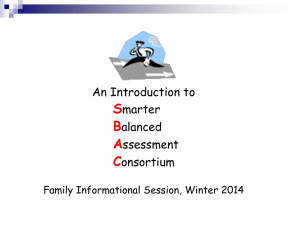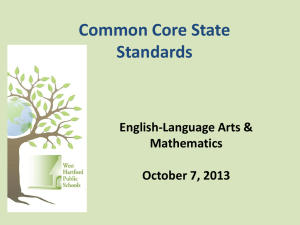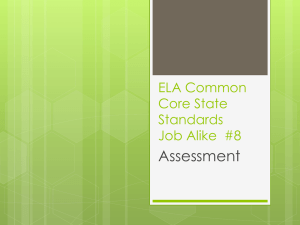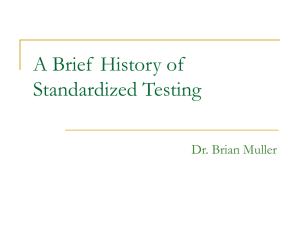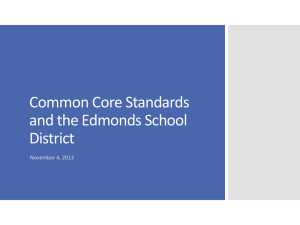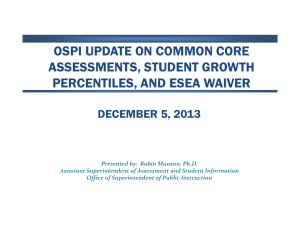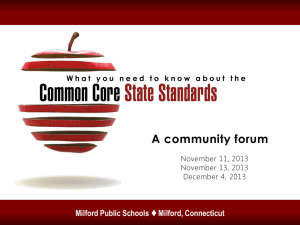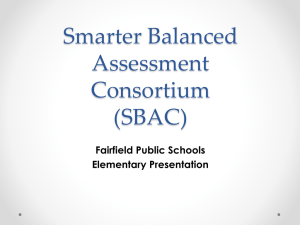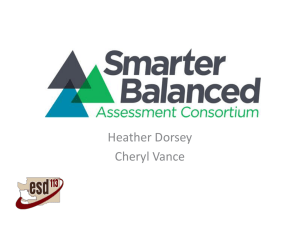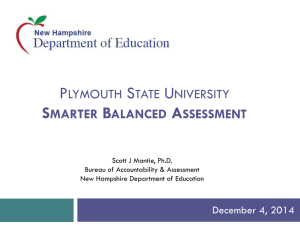SBAC Support Power Point Presentation
advertisement
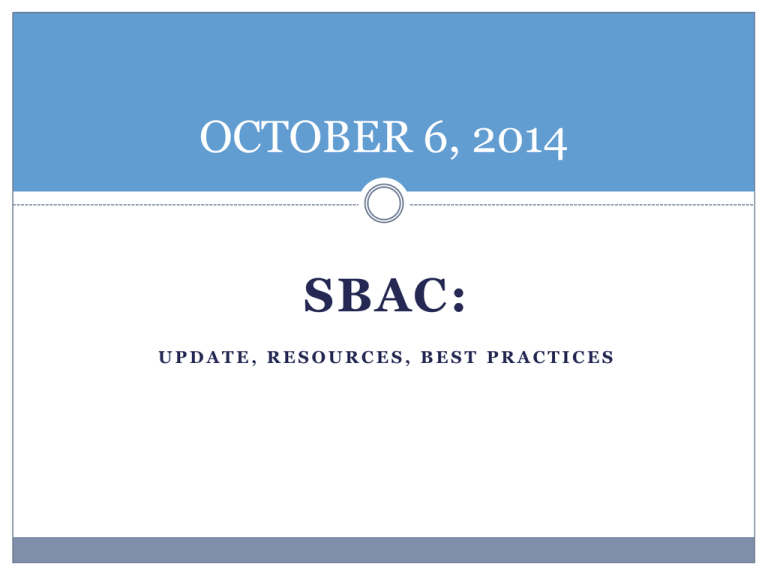
OCTOBER 6, 2014 SBAC: UPDATE, RESOURCES, BEST PRACTICES SBAC: Preparing Students and Communities Fall staff training day – all staff spend time reviewing SBAC website and training modules Create a schedule for students to have an opportunity to take practice test Letter to parents about SBAC and process Articles in District newsletters about SBAC for community Moving from MSP/HSPE to SBAC Smarter Balanced is to measure high standards – not a high school diploma by tenth grade – but college and career readiness no sooner than eleventh grade. Communicating Reasoning (Math Claim #3) Students can clearly and precisely construct viable arguments to support their own reasoning and to critique the reasoning of others. Research/Inquiry (ELA Claim #4) Students can engage in research and inquiry to investigate topics, and to analyze, integrate, and present information. Smarter Balanced Assessment Claims Students can demonstrate college and career readiness in mathematics. Concepts and Procedures Communicating Reasoning Problem Solving Modeling and Data Analysis Students can demonstrate college and career readiness in English language arts and literacy. Reading Writing Speaking and Listening Research/Inquiry What did the SBAC Field Test Districts Learn? Scheduling Accommodations Flexible schedules (i.e. libraries Universal tools, designated and lab time) to handle varying testing times Classroom Activity Testing over weeks – not one and done Spring athletics, field trips, competitions Other exams, Running Start, and more mixed grade level classes supports and accommodations Students not familiar with functionality – what if tools are not used outside of testing Start planning early What did the SBAC Field Test Districts Learn? Students Adults Not using all the tools – Proctors use portal to practice is not passive Not familiar manipulating screen panes Keyboarding Are not reading directions Lots of onscreen reading Math tools are clunky Enter in 17 characters from a ticket to start test Start practice earlier manage tests online Need to know how to use tools – practice is not passive Use dedicated staff to proctor tests Training materials are numerous (SBAC website) Start training earlier What did the SBAC Field Test Districts Learn? Technology/Environment Meet the tech requirements SBAC Field Testing Summary: Ensure enough wireless Laptops, batteries, mice 4.2 million students tested Headphones and ear buds 12.2 million tests completed Learning spaces versus 16.5 thousand schools tested testing spaces Coordinated Tech support (internal and external) 1,100 Help Desk inquiries each day It worked! Similarities Differences Online (for districts who Computer adaptive gave MSP/HSPE online) Selected response Short answer and constructed response Essay writing Performance task Classroom activity Listening items Text complexity Brief write, revise, edit SBAC – What is Assessed SBAC is comprised of two separate assessments: the non–performance task (non- PT) items and the Classroom Activity/performance task (PT). Smarter Balanced recommends that students take the PT and the non-PT items on separate days in the following sequence: 1. Non-PT items 2. Classroom Activity 3. PT items If districts/schools elect to administer these in a different order, the Classroom Activity must always occur prior to the administration of the PT. ELA (English Language Arts) Non–Performance Task – one day/time period Performance Task – one day/time period Classroom Activity – one day or time period prior to Performance Task exam Math Non–Performance Task – one day/time period Performance Task – one day/time period Classroom Activity – one day or time period prior to Performance Task exam Classroom Activity The Classroom Activity introduces students to the context of a performance task, so they are not disadvantaged in demonstrating the skills the task intends to assess. Contextual elements include: an understanding of the setting or situation in which the task is placed, potentially unfamiliar concepts that are associated with the scenario, and key terms or vocabulary students will need to understand in order to meaningfully engage with and complete the performance task. The Classroom Activity is also intended to generate student interest in further exploration of the key idea(s). The Classroom Activity should be easy to implement with clear instructions. Who is Testing and What is being Tested in 2014 - 2015? 3rd Grade – SBAC (ELA & Math) 4th Grade – SBAC (ELA & Math) 5th Grade – SBAC (ELA & Math) and MSP Science 6th Grade – SBAC (ELA & Math) 7th Grade – SBAC (ELA & Math) 8th Grade – SBAC (ELA & Math), MSP Science and Math EOC 9th Grade – Math EOC and/or Biology EOC 10th Grade – ELA Exit Exam (HSPE like; paper/pencil), Math EOC and/or Biology EOC 11th Grade – Needed Exit Exams and SBAC (ELA & Math) – used for AYP purposes 12th Grade – Needed Exit Exams State Testing Dates / Window Smarter Balanced 2015 Testing Windows Grade 3 ELA March 9 to April 23 Grade 3 Math Last 12 weeks of school, but no earlier than March 9 and no later than June 15 Grades 4–8 ELA and Math Last 12 weeks of school, but no earlier than March 9 and no later than June 15 Grade 11 ELA and Math Last 7 weeks of school, but no earlier than April 6 and no later than June 15 Measurements of Student Progress (MSP) 2015 Testing Windows Grades 5 and 8 Science May 12 High School Exit Exams (HSPE) (DAPE) (EOC) (ELA) 2015 Testing Windows Grades 11 and 12 HSPE Retake o Reading o Writing March 17 March 18–19 Grade 10 ELA exit exam May 12–13 OR May 19 –20 Biology EOC exit exams May 26 – 30 Math EOC exit exam June 2 – 5 Developmentally Appropriate Proficiency Exam (DAPE) Last 12 weeks of school, but no earlier than March 9 and no later than June 15 – online Smarter Balanced Practice Test Smarter Balanced Assessment Resources Next Steps DEVELOP DISTRICTWIDE SCHEDULE PRACTICE, PRACTICE, PRACTICE Students & Staff Members (proctors) COMMUNICATION TO ALL STAKEHOLDERS Your Questions
